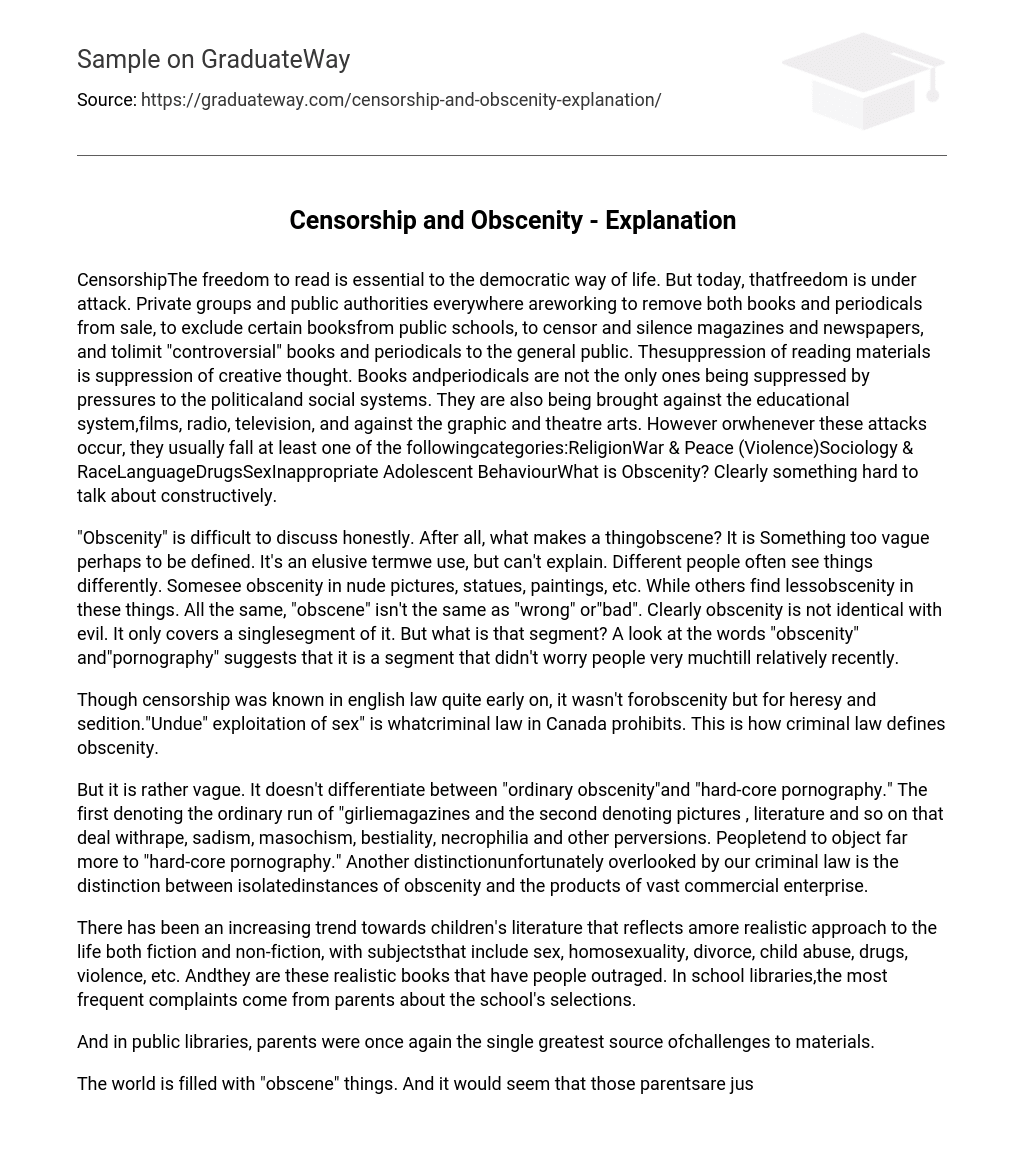CensorshipThe freedom to read is essential to the democratic way of life. But today, thatfreedom is under attack. Private groups and public authorities everywhere areworking to remove both books and periodicals from sale, to exclude certain booksfrom public schools, to censor and silence magazines and newspapers, and tolimit “controversial” books and periodicals to the general public. Thesuppression of reading materials is suppression of creative thought. Books andperiodicals are not the only ones being suppressed by pressures to the politicaland social systems. They are also being brought against the educational system,films, radio, television, and against the graphic and theatre arts. However orwhenever these attacks occur, they usually fall at least one of the followingcategories:ReligionWar & Peace (Violence)Sociology & RaceLanguageDrugsSexInappropriate Adolescent BehaviourWhat is Obscenity? Clearly something hard to talk about constructively.
“Obscenity” is difficult to discuss honestly. After all, what makes a thingobscene? It is Something too vague perhaps to be defined. It’s an elusive termwe use, but can’t explain. Different people often see things differently. Somesee obscenity in nude pictures, statues, paintings, etc. While others find lessobscenity in these things. All the same, “obscene” isn’t the same as “wrong” or”bad”. Clearly obscenity is not identical with evil. It only covers a singlesegment of it. But what is that segment? A look at the words “obscenity” and”pornography” suggests that it is a segment that didn’t worry people very muchtill relatively recently.
Though censorship was known in english law quite early on, it wasn’t forobscenity but for heresy and sedition.”Undue” exploitation of sex” is whatcriminal law in Canada prohibits. This is how criminal law defines obscenity.
But it is rather vague. It doesn’t differentiate between “ordinary obscenity”and “hard-core pornography.” The first denoting the ordinary run of “girliemagazines and the second denoting pictures , literature and so on that deal withrape, sadism, masochism, bestiality, necrophilia and other perversions. Peopletend to object far more to “hard-core pornography.” Another distinctionunfortunately overlooked by our criminal law is the distinction between isolatedinstances of obscenity and the products of vast commercial enterprise.
There has been an increasing trend towards children’s literature that reflects amore realistic approach to the life both fiction and non-fiction, with subjectsthat include sex, homosexuality, divorce, child abuse, drugs, violence, etc. Andthey are these realistic books that have people outraged. In school libraries,the most frequent complaints come from parents about the school’s selections.
And in public libraries, parents were once again the single greatest source ofchallenges to materials.
The world is filled with “obscene” things. And it would seem that those parentsare just trying to protect their children from the outside world. But does itreally help? These day, an average elementary school student knows many things.
They are influenced by a wide range of sources, from television and other formsof media, their environment at home and school, their personality and theirbackground. Why they read does not necessarily mean that they will follow.
Literature is a valued source of knowledge for these children, and should not beheld back. So rather than applying full censorship, it should be made an age-related censorship. Many of the complaints that were issued were of theimmaturity of the readers. And younger children should be prevented fromborrowing material intended for an older age group. Controversial materialsshould still be held either in reserve stock, available on request, or under asection for parents and teachers who can decide for themselves whether thematerial is suitable or not.
Our would is not perfect. We are a world filled with violence, sex, racism, etc.
Certain literature like “hard-core pornography” should be censored to thegeneral public. These types of “explicit sex” truly have no meaning. Theydegrade the human race by increasing physical, mental and sexual abuse againstwomen, animals, and sometimes against men. These inhuman treatments should notbe shown to prevent other potential people from “experimenting” these acts ofdisgust. “Ordinary obscenity” should be censored closely, but with an objectiveview. They may also cause an increase in the violence against women, so theymust be reduced and kept out of reach of the immature readers. To make a treegrow correctly, you must start caring from the very beginning. You must notblock its nutrients, water nor sunlight, but allow it to move around a bit. Wehave a governing social system that mainly frowns upon the violence againstwomen. There should indeed be access to most types of literature, but in varyingdegrees of freedom, determined not by censorship, but by controlled access.
Parents are trying to protect their children from the harsh realities of life,but are they really helping, or hindering?BibliographyThe Censorship Iceberg: The results of a survey of challenges in school andpublic libraries. By Dr. David Jenkins. School Libraries in Canada. Fall, 1985.
v.6 n.1 p19-22Sanitized textbooks reflect a pious paradise that never was. By June Callwood.
The Globe and Mail. March 18, 1987. pA2-A3Suffer the little children. By Janet Collins. Books in Canada. October 1991.
v.20 n.7 p25-27Court bans ‘humanist’ books from Alabama public schools. By Robin Toner. TheGlobe and Mail. March 5, 1987. pA10Censorship in the children’s library. By Rupert Colley. The Junior Bookshelf.
June 1990. v.54 n.3 p121-123Censorship News. Spring 1985. n20Limits of criminal law – obscenity: a test case. By The Law Reform Commission:working paper no. 10. p7-9Censorship: stopping the book banners. By the book and periodical developmentcouncil. August 1988. p1-17





